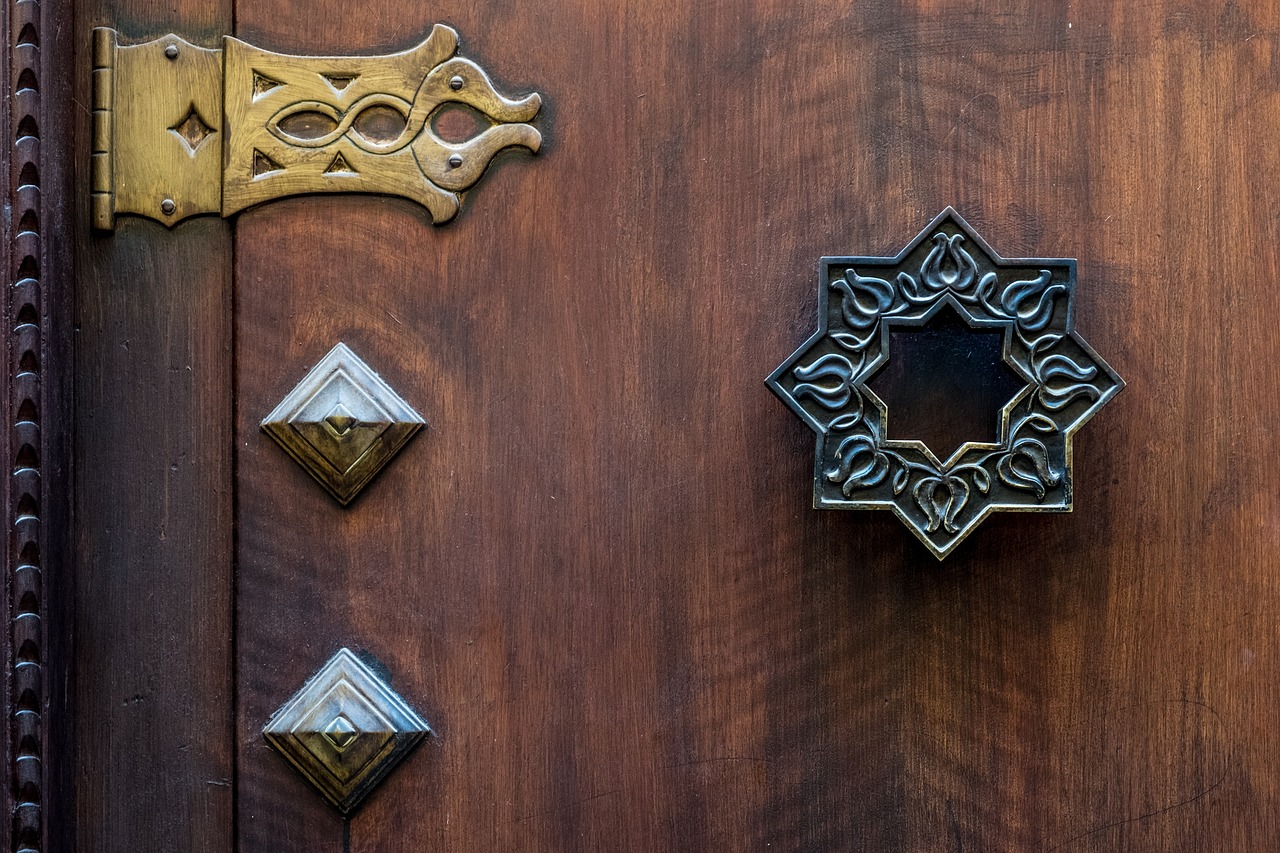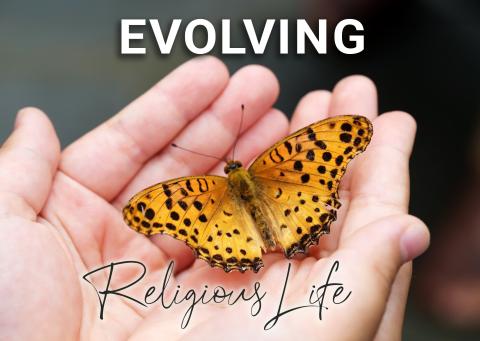
(Pixabay/Manolo Franco)
Editor's note: "Evolving Religious Life," a new series from Global Sisters Report, is exploring how Catholic sisters are adapting to the realities of congregations in transition and new forms of religious life. While we write often about these trends, this particular series will focus more closely on sisters' hopes for the future.
"Behold, I stand at the door and knock. If anyone hears my voice and opens the door, [then] I will enter his house and dine with him, and he with me." (Revelation 3:20)
Every Tuesday at 8 p.m. we offer a silent meditation session followed by a prayerful reading of a biblical text (lectio divina) online. Over the last few weeks, while praying the Word with the international community, I have been given the gift of a word and a suggestion: "Be a hinge."

As I observe the reality of consecrated life and listen to the people and the Spirit, I hear a knock at the door of my imagination, my heart, my creativity and my commitment, telling me it's time to facilitate and accompany the resurgence of a new model of consecrated life. It is time to evolve, to heed the gentle knock of the Ruah at the door, desiring to come in and share the table of our fears, doubts and dreams. She wants to share the bread earned with our work, in a rented apartment like any normal/ordinary person, without privileges.
It is evident that in today's reality, the traditional model of consecrated life tied to an institution is obsolete. The ministry model of the past is in urgent need of updating.
The Ruah immerses us in the reality of the people to whom we are sent, leading us on a journey from "doing for them" to "being and living like them." During this transition, we let go of our distinctive ranks and embrace an evangelical life inspired by our original vocation, now renewed.
Do I understand the historical moment in which I live and the necessary steps to adapt to the current reality?
I feel like a worm inside a cocoon. I can't quite describe the giddy feeling I'm experiencing. Like the worm, I have stopped being what I used to be and now I wait in the dark and alone for this slow metamorphosis. This process may take a long time until, slowly, very slowly, I begin to glimpse some light, some future, some inner indication. This image deeply resonates with me and expresses the situation in which many of us religious find ourselves.
This whole process of being a hinge happens gradually, following the rhythm of the Ruah. We are immersed in kairos time: God's time, without the urgency of chronological time that pushes us, urges us, demanding answers.

(Pixabay/Logga Wiggler)
Will it lead to prophetic thought, less security and more interpersonal relationships among ourselves and with people on equal footing?
Will it become a manner of presenting ourselves not merely as professionals of the divine, but as humble sisters who walk side by side with everyone?
The gentle knock of the Ruah is soft and present at the door, waiting. For what? What should I, what should we open ourselves to?
It is evident that in today's reality, the traditional model of consecrated life tied to an institution is obsolete. The ministry model of the past, which formed the basis of many congregations, is in urgent need of updating.
Before we can rebuild, we must deconstruct. Similar to the approach taken with the great ecological buildings of today, as we deconstruct, brick by brick, we must keep in mind the preservation and recycling of what doesn't age, or deteriorate with the passage of time. The essential elements never become obsolete
And it is precisely at this point that the image of a hinge reveals to me what it might mean to be a consecrated woman in today's world.
According to the dictionary, "A hinge is an object consisting of two pieces that share a common axis, enabling them to move and thereby connecting the two elements."
You and I are hinges, bridging the past and the future within our communities.
You and I are hinges, bridging the past and the future within our communities. Perhaps, in order to evolve toward a future model that is less rigid and more relational, less structured and more prophetic, we ought to contemplate using this imagery and pose the following questions:
What aspects from the past do I wish to preserve or reclaim?
What do I urgently need to integrate in order to lay the foundation of the present moment in our journey toward a meaningful consecrated life today?
I am conscious of speaking in the singular because I recognize that this transformation starts with each individual. Renewing our minds and hearts isn't achieved collectively; it's the knock at the door of each of our lives that will mold a new model of consecrated life.
The hinge is centered on its axis, securely fastened, enabling continuous movement from one side to the other.
It's not about abandoning the past, but rather being firmly rooted in the Spirit of the Risen Jesus, in constant evolution, and opening ourselves to reclaim the foundational and fundamental aspects of the past in order to reshape our narrative.
It is said to be easy, but doing it is a task of giants of spirit. It is difficult to depart from the familiar, to take the initial step, to go out to meet people when before it was they who were looking for us.
This is the path of evolution, a gradual process. It entails shedding the silk cocoons' safety nets in which some of us may be partially concealed, ultimately emerging into the light.
Let's not overlook that embracing the process and remaining within the cocoon, serving as hinges, even without a clear vision of our destination, grants us wings. Priceless butterfly wings, capable of soaring in our moments of prayerful silence, back and forth from the heart of the resurrected one toward those yearning to be lifted from their sense of meaninglessness.
I firmly believe that we offer ourselves completely when we connect with that steadfast axis, the Ruah, which keeps us grounded and empowers us to deconstruct and rebuild. In my case, within the community, it has enabled me to utilize new technologies for evangelization rooted in my original charism: prayer and preaching.
We share the Word of God, studied and prayed, utilizing platforms such as Zoom, WhatsApp and audio messages. Beyond simply sharing the Word, we also extend the embrace of silence by providing spaces for online and in-person companionship in quiet reflection. This work involves more intense preparation as everything is recorded, but the effort is worth it.
It is fascinating how anyone from any country can connect to a Zoom at any given moment and how audio messages can reach the older sister resting in bed, the young woman in mission, the person driving for hours, or the one walking in prayer.
The first time we offered an Easter celebration online during the pandemic, we welcomed over 5.000 participants, a stark contrast to the small in-person gathering of just 20 people. This challenges us as a community and encourages us to rethink another way of working. It means undertaking other studies and adapting in different ways.
The gentle knock of the Ruah is soft and present at the door, waiting. For what? What should I, what should we open ourselves to?
Advertisement
We can offer courses on the Gospels of Mark or John, focusing on the practice of prayer and the integration of ecological values and love for the Earth. This approach challenges us to constantly renew both our theology and our ecclesiology, day by day. Offering the course online has proven to have a greater impact, reaching even remote places.
In addition, maintaining our blog with rich content is essential. On a daily basis, people search for meaning in it, which indicates to me the importance of serving as a hinge in engaging with sacred texts. We connect with the sacred texts with today's eyes, writing in such a way that the Word can be accessible and applied in daily life.
GSR has encouraged me to write more often and become better and to encourage us, and has fostered among women religious the opportunity to only to share what we do, but also who we are and how we are living the process of metamorphosis toward the light.
This is the path of evolution, a gradual process. It entails shedding the silk cocoons' safety nets in which some of us may be partially concealed, ultimately emerging into the light.
How different it is to translate compared to praying with the text that one of you has written, trying to convey the spirit of the ministry it tells us about! Many times, after translating a column, I have been so moved that in my prayer I can no longer find the Word; yours becomes the Word made flesh. For all this, I thank those of you who dare to write because you transmit life.
The community to which I belong, Sisters For Christian Community, emerged from a group of women who had the courage to write their own history. These sisters, religious from different congregations, faced the enormous task entrusted by the Second Vatican Council to update (aggiornamento) consecrated life in alignment with the current historical moment. Acting as hinges, they ushered in a new congregational model, liberated from institutional constraints, possessions, and hierarchies. Embracing an ecumenical and non-canonical status, they exercised the autonomy to choose their internal organization and structure.
Perhaps a relational and interpersonal model, based on the joint search for a path, is the first step toward that urgent evolution that is pushing us, as a child who wants to be born and needs to make its way. To achieve this, we must dilate, open and fight for life.
This story was originally published in Spanish on March 20, 2024.







